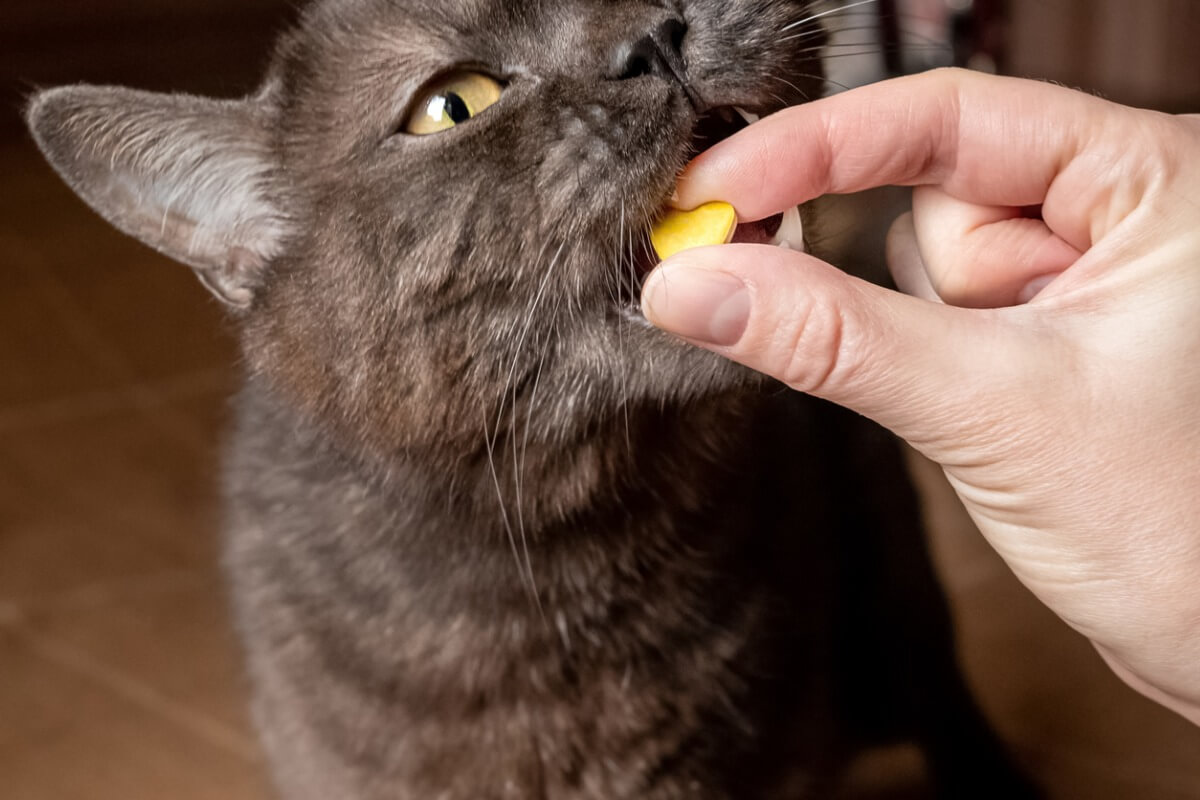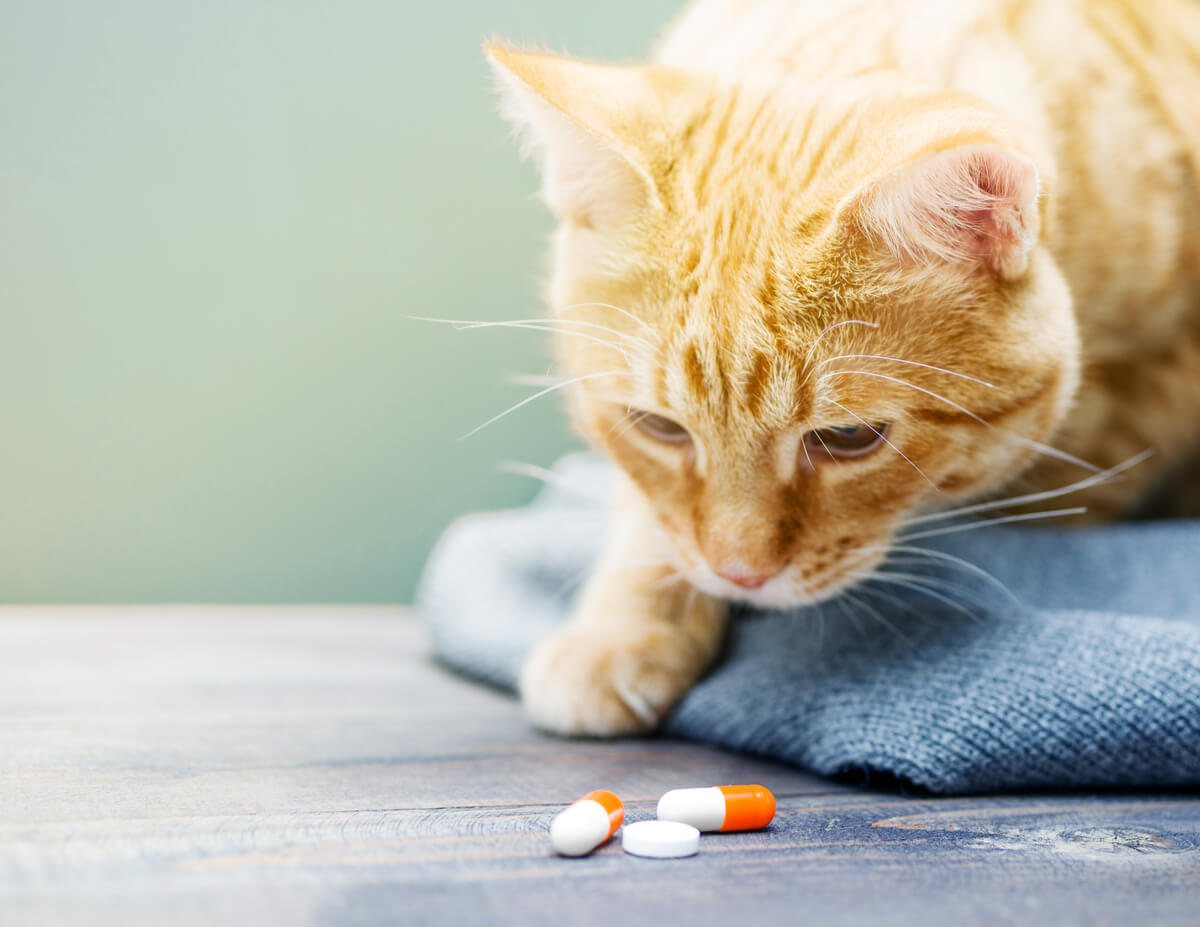Credelio for Cats: Dosage and Side Effects

Credelio for cats is the name given to the first oral tablet for the treatment of tick and flea infestations for this species. The objective of the creation of this deworming format is to facilitate the administration of the drug to domestic felines, notorious for suffering stress during veterinary handling in the clinic and at home.
Credelio is produced in the form of small, chewable, and palatable tablets. For this reason, it has become one of the most popular medications among owners, although it’s recommended that its administration is always supervised by a veterinarian. In this article, you can read about its characteristics and the precautions to take into account with this antiparasitic. Read on to find out more.
What is credelio for cats?
The active ingredient of credelio for cats is lotilaner, an enantiomer of the isoxazoline class. This chemical compound is effective against fleas, which die within 8 hours, and ticks, which take about 18 hours to die and detach from the cat’s skin after exposure.
Lotilaner becomes effective when it reaches its peak concentration in the felid’s bloodstream. Parasites that were feeding on the cat’s blood (such as fleas) at the time of treatment ingest the chemical at the same time and die when it affects their primitive nervous system.
One of the advantages of this medication is that it interrupts the fleas’ life cycle, eliminating them before they can lay eggs (as long as the treatment is used as prevention).
The effect of credelio lasts for about a month, so its administration has to be regular throughout the year. Depending on the area, it may only be necessary to administer it during the months of greatest risk (such as summer or spring when temperatures rise). The veterinarian will decide this guideline.

Uses of credelio for cats
Credelio is prescribed preventively or when the cat is actually suffering from an infestation of external parasites. It’s specifically for fleas of the species Ctenocephalides felis and Ctenocephalides canis and ticks of the species Ixodes ricinus. The latter are the only mites that the drug is effective against.
Credelio: dosage for cats
Credelio is marketed in chewable tablets for oral administration and should be offered to the cat with its usual meal or up to 30 minutes afterwards to ensure its effectiveness. Depending on the weight of the animal, it comes in various forms:
- Credelio 12 milligrams: For cats weighing between 0.5 and 2 kilograms.
- Credelio 38 milligrams: Indicated for cats weighing between 2 and 8 kilograms.
For felids weighing more than 8 kilograms, the veterinarian will adjust the number of tablets to be administered. However, the recommended dose can’t be less than 6 milligrams or more than 24 milligrams per kilogram of weight of the animal in any case.
Contraindications of the drug
The administration of this drug isn’t recommended for tick infestations in kittens under 5 months of age, as its efficacy isn’t proven in this age range. Neither can it be given to kittens less than 8 weeks old or weighing less than 0.5 kg. However, the veterinarian will decide if the specific situation of the animal could require this medication.
There’s also insufficient data regarding pregnant or lactating cats. Again, in this situation, it’s up to the veterinarian to assess the risks when treating a cat in this condition.
Side effects of credelio for cats
Credelio is a fairly safe drug and no serious adverse reactions from its use have been identified. Neither is there any evidence that it can interact with other medications that the cat may be taking at the time of infestation. However, the package leaflet states that, on very rare occasions, it may cause some of these side effects:
- Vomiting
- Diarrhea
- Lack of appetite (anorexia)
- Lethargy
These are transient and don’t require specific treatment. On very rare occasions, neurological disturbances such as tremors, ataxia (difficulty in moving in a coordinated manner), or convulsions have been reported. Fortunately, these are also signs that disappear on their own.
Warnings and precautions
For credelio to be effective, the parasites must be able to feed on the cat’s blood. If they don’t, then they won’t ingest the active ingredient, so they aren’t affected by the pharmacological process.
This has a major disadvantage. Despite its effectiveness, the cat is still exposed to diseases transmitted by fleas and ticks when biting, such as ehrlichiosis, tularemia, or Lyme disease. Therefore, the best prevention to avoid infections transmitted by vectors will be repellent collars and pipettes.
Credelio only causes the death of the invertebrate once it has bitten the cat.

You may have noticed that veterinary judgement is often mentioned in this article. This is because, even though it’s an over-the-counter medication, it requires a vet’s assessment to administer it. Whenever you detect an infestation in your feline or want to start a prevention program, go to your local clinic.
Credelio for cats is the name given to the first oral tablet for the treatment of tick and flea infestations for this species. The objective of the creation of this deworming format is to facilitate the administration of the drug to domestic felines, notorious for suffering stress during veterinary handling in the clinic and at home.
Credelio is produced in the form of small, chewable, and palatable tablets. For this reason, it has become one of the most popular medications among owners, although it’s recommended that its administration is always supervised by a veterinarian. In this article, you can read about its characteristics and the precautions to take into account with this antiparasitic. Read on to find out more.
What is credelio for cats?
The active ingredient of credelio for cats is lotilaner, an enantiomer of the isoxazoline class. This chemical compound is effective against fleas, which die within 8 hours, and ticks, which take about 18 hours to die and detach from the cat’s skin after exposure.
Lotilaner becomes effective when it reaches its peak concentration in the felid’s bloodstream. Parasites that were feeding on the cat’s blood (such as fleas) at the time of treatment ingest the chemical at the same time and die when it affects their primitive nervous system.
One of the advantages of this medication is that it interrupts the fleas’ life cycle, eliminating them before they can lay eggs (as long as the treatment is used as prevention).
The effect of credelio lasts for about a month, so its administration has to be regular throughout the year. Depending on the area, it may only be necessary to administer it during the months of greatest risk (such as summer or spring when temperatures rise). The veterinarian will decide this guideline.

Uses of credelio for cats
Credelio is prescribed preventively or when the cat is actually suffering from an infestation of external parasites. It’s specifically for fleas of the species Ctenocephalides felis and Ctenocephalides canis and ticks of the species Ixodes ricinus. The latter are the only mites that the drug is effective against.
Credelio: dosage for cats
Credelio is marketed in chewable tablets for oral administration and should be offered to the cat with its usual meal or up to 30 minutes afterwards to ensure its effectiveness. Depending on the weight of the animal, it comes in various forms:
- Credelio 12 milligrams: For cats weighing between 0.5 and 2 kilograms.
- Credelio 38 milligrams: Indicated for cats weighing between 2 and 8 kilograms.
For felids weighing more than 8 kilograms, the veterinarian will adjust the number of tablets to be administered. However, the recommended dose can’t be less than 6 milligrams or more than 24 milligrams per kilogram of weight of the animal in any case.
Contraindications of the drug
The administration of this drug isn’t recommended for tick infestations in kittens under 5 months of age, as its efficacy isn’t proven in this age range. Neither can it be given to kittens less than 8 weeks old or weighing less than 0.5 kg. However, the veterinarian will decide if the specific situation of the animal could require this medication.
There’s also insufficient data regarding pregnant or lactating cats. Again, in this situation, it’s up to the veterinarian to assess the risks when treating a cat in this condition.
Side effects of credelio for cats
Credelio is a fairly safe drug and no serious adverse reactions from its use have been identified. Neither is there any evidence that it can interact with other medications that the cat may be taking at the time of infestation. However, the package leaflet states that, on very rare occasions, it may cause some of these side effects:
- Vomiting
- Diarrhea
- Lack of appetite (anorexia)
- Lethargy
These are transient and don’t require specific treatment. On very rare occasions, neurological disturbances such as tremors, ataxia (difficulty in moving in a coordinated manner), or convulsions have been reported. Fortunately, these are also signs that disappear on their own.
Warnings and precautions
For credelio to be effective, the parasites must be able to feed on the cat’s blood. If they don’t, then they won’t ingest the active ingredient, so they aren’t affected by the pharmacological process.
This has a major disadvantage. Despite its effectiveness, the cat is still exposed to diseases transmitted by fleas and ticks when biting, such as ehrlichiosis, tularemia, or Lyme disease. Therefore, the best prevention to avoid infections transmitted by vectors will be repellent collars and pipettes.
Credelio only causes the death of the invertebrate once it has bitten the cat.

You may have noticed that veterinary judgement is often mentioned in this article. This is because, even though it’s an over-the-counter medication, it requires a vet’s assessment to administer it. Whenever you detect an infestation in your feline or want to start a prevention program, go to your local clinic.
All cited sources were thoroughly reviewed by our team to ensure their quality, reliability, currency, and validity. The bibliography of this article was considered reliable and of academic or scientific accuracy.
- Agencia Europea de Medicamentos. (2019). FICHA TÉCNICA O RESUMEN DE LAS CARACTERÍSTICAS DEL PRODUCTO. https://www.ema.europa.eu/en/documents/product-information/credelio-epar-product-information_es.pdf
- Credelio para Gatos, el primer comprimido mensual contra garrapatas y pulgas, gana el premio Easy to Give de la ISFM | PortalVeterinaria. (2019). PortalVeterinaria. Recuperado 4 de noviembre de 2021, de https://www.portalveterinaria.com/animales-de-compania/empresas/32164/credelio-para-gatos-el-primer-comprimido-mensual-contra-garrapatas-y-pulgas-gana-el-premio-easy-to-give-de-la-isfm.html
- Young, L., Karadzovska, D., Wiseman, S., & Helbig, R. (2020). Efficacy of lotilaner (Credelio™) against the adult cat flea, Ctenocephalides felis and flea eggs following oral administration to dogs. Parasites & vectors, 13(1), 1-6.
This text is provided for informational purposes only and does not replace consultation with a professional. If in doubt, consult your specialist.








